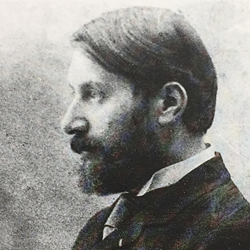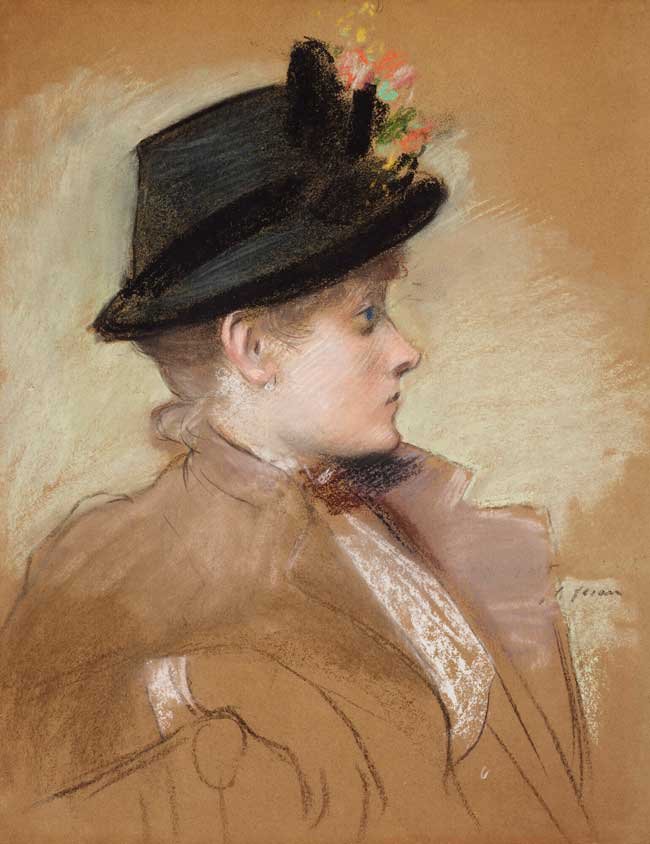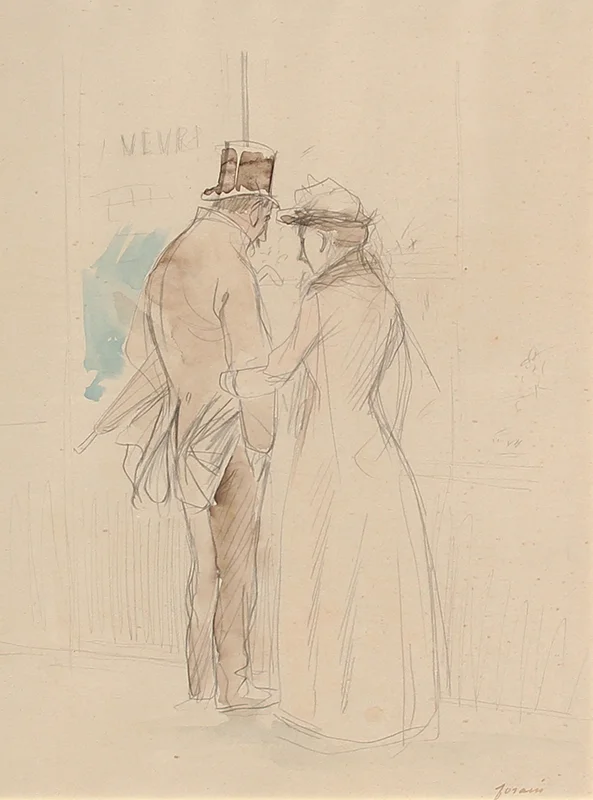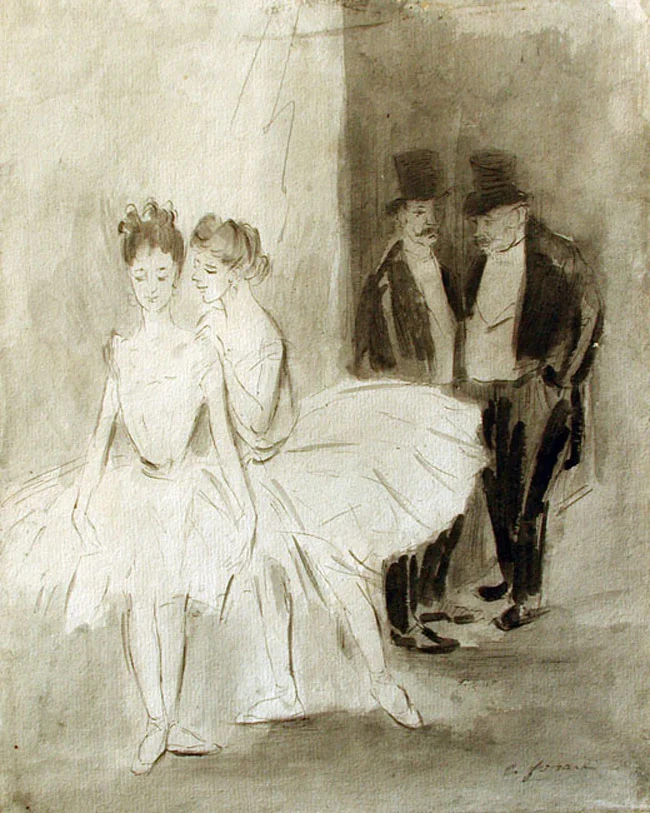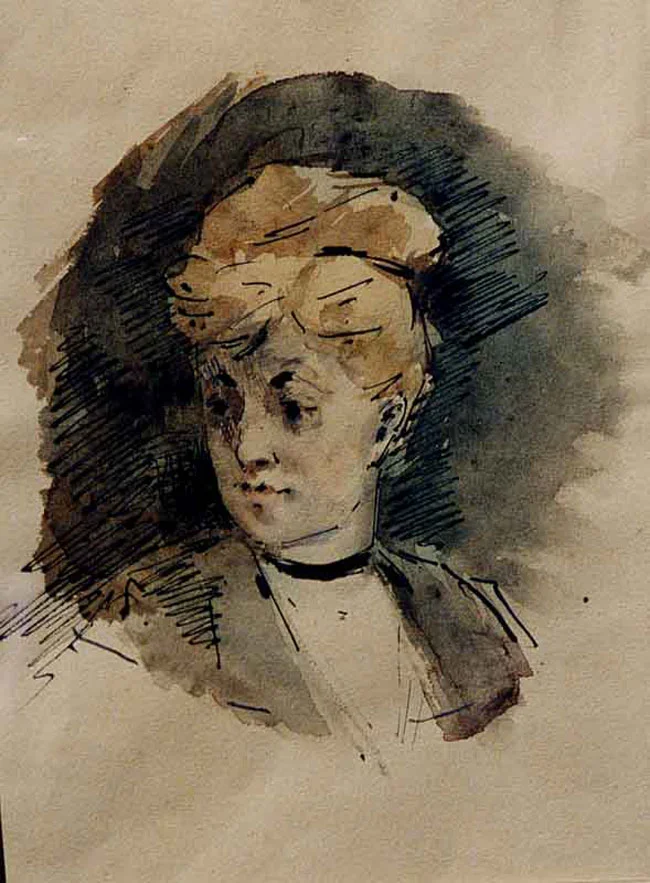JEAN-LOUIS FORAIN PAINTINGS FOR SALE & BIOGRAPHY
JEAN-LOUIS FORAIN
French, 1852–1931
BIOGRAPHY
“Jean-Louis Forain was a French painter, printmaker and illustrator. Around 1860 he moved with his family to Paris, where he was taught by Jacquesson de la Chevreuse (1839–1903), Jean Baptiste Carpeaux and André Gill. He participated in the Franco-Prussian War (1870–71) and was a friend of the poets Paul Verlaine and Arthur Rimbaud. Forain first met Manet through his friendship with Degas in the early 1870s at the salon of Nina de Callias. He continued to associate with Manet, meeting the group of young Impressionists at the Café Guerbois and the Café de la Nouvelle Athènes. In 1878 Forain painted a small gouache, Café Scene (New York, Brooklyn Mus.), which probably influenced Manet’s Bar at the Folies-Bergère (1881–2; London, Courtauld Inst. Gals).
“In 1879 Forain was invited by Degas to join the fourth Impressionist exhibition, and he exhibited again with the Impressionists in the fifth (1880), sixth (1881) and eighth (1886) exhibitions, receiving favorable reviews from Huysmans, Félix Fénéon and Diego Martelli. He lightened his palette and employed the Impressionist methods of short brushstrokes and complementary color juxtapositions to create some luminous plein-air paintings. As Huysmans pointed out, one of Forain’s most successful subjects was the Parisian woman, who appeared in many guises in the works of his Impressionist period (c. 1879–1900). Like Degas, who was his best friend and the greatest influence on him, Forain depicted scenes backstage at the Opéra and at the race-track as well as nudes in naturalistic interiors, often drawing from the same model with Degas. Unlike Degas, Forain exhibited at the Salon des Artistes Français, showing the Buffet (Paris, Féd. Mutualiste) in 1884 and the Widower (Paris, Louvre) in 1885. Both have more formal compositions, and the figures are solidly delineated, but they also demonstrate Forain’s Impressionist principles in the low viewpoint and diagonal composition influenced by Japanese woodcuts, the freely brushed surfaces and the interest in the effects of light.
“Forain’s career as an illustrator began in 1876 when his first published drawing appeared on the cover of Le Scapin. He worked regularly for the Courrier français from 1887 and drew albums for Le Figaro in 1891: he worked on Le Figaro intermittently for the next 35 years. His drawings for the Courrier français made him famous, his captions so witty and biting that they were described as written in vitriol, and he was known as the ‘Juvénal du Figaro.’
“Forain began printmaking in the mid-1870s. In his first etching period (1875–90) his subjects were backstage views, café-concerts and the Folies-Bergère. He also etched illustrations to Huysmans’sMarthe (1876) and Croquis parisiens (1880). In 1890 he took up lithography with scenes of Parisian life, often several versions of the same subject, such as his six plates of the Private Room. He also created some memorable portraits in this medium such as the elegant Colette Willy, four brilliant portraits of Renoir and two of Ambroise Vollard. He resumed etching in 1902 but changed his subject matter to concentrate on religious and courtroom subjects of great drama and deep feeling, expressed with bravura technique.
“After 1900 Forain’s painting style also underwent a change, both in technique and subject matter. The latter change was the result of Forain’s experience of the Dreyfus trials, which also prompted him to co-found, with Caran d’ache, the weekly satirical journal Psst!, and his renewal of Christian faith in the company of his old friend Huysmans in 1900 at Ligugé: he began to paint biblical and law-court scenes and, in 1915, pictures inspired by World War I. The colors of his work became somber, reflecting the expressive qualities of this new subject matter. Among his most moving religious representations are the oil painting the Prodigal Son (1909; Boston, MA, Pub. Lib.) and the series of etchings on the same subject. Forain presented this as a contemporary drama of reconciliation, with the figures shown in contemporary dress and attitudes, rather than as a historical biblical scene. Forain’s law-court scenes contrast the vulnerability of the defendant with the bored indifference or histrionic gestures of the lawyers. His paintings were championed in 1910 by Octave Maus, resulting in a retrospective of over 400 works at the Musée des Arts Décoratifs, Paris, which revealed the scope of Forain’s oeuvre and established him as a major artist.
“In February 1915, aged 62, Forain joined the camouflage corps and later became a correspondent for Le Figaro, covering all phases of World War I with biting, satirical images of the futility of war. He ended his career as President of the Société Nationale des Beaux-Arts, member of the Académie Française and Commandant de la Légion d’honneur. His work was admired by Degas, Manet and Cézanne, and a generation of social realists was influenced by his biting pictorial condemnations of injustice, greed, lust, stupidity and the horrors of war” (Craig, The Oxford Companion to Western Artists).
Museum Collections:
Art Gallery of Greater Victoria, British Columbia
Art Institute of Chicago, Chicago, IL
Ashmolean Art Gallery and Museums, Oxford
Brooklyn Museum, Brooklyn, NY
Christchurch Art Gallery (Te Puna O Waiwhetu), Christchurch
Cleveland Museum of Art, Cleveland, OH
Courtauld Institute of Art, London
Dublin City Gallery, Dublin
Fine Arts Museums of San Francisco, San Franscisco, CA
Fitzwilliam Museum, Cambridge
Fred Jones Jr. Museum of Art, University of Oklahoma, OK
Georgetown University, Washington D.C.
Harvard University Art Museums, Cambridge, MA
Hermitage Museum, St. Petersburg
Hirshhorn Museum and Sculpture Garden, Washington, D.C.
Los Angeles County Museum of Art, Los Angeles
Metropolitan Museum of Art, New York, NY
Mildred Lane Kemper Art Museum, St. Louis, MO
Minneapolis Institute of Arts, Minneapolis, MN
Musée d’Orsay, Paris
Musée Magnin, Dijon
Museo Nacional de Bellas Artes, Buenos Aires
Museum of Fine Arts, Boston, MA
Museum of Modern Art, New York, NY
Museum voor Schone Kunsten, Gent
National Gallery, London
National Gallery of Art, Washington, D.C.
National Gallery of Canada, Ottawa
National Museum of Art of Romania, Bucharest
Norton Simon Museum, Pasadena, CA
Philadelphia Museum of Art, Philadelphia, PA
Phoenix Art Museum, Phoenix, AZ
Princeton University Art Museum, Princeton, NJ
Statens Museum for Kunst, National Gallery of Denmark, Copenhagen
Tate Gallery, London
Thyssen-Bornemisza Museum, Madrid
Valtion Taidemuseo, Finnish National Gallery, Helsinki
Mark Murray Fine Paintings is a New York gallery specializing in buying and selling 19th century and early 20th century artwork.
Please contact us if you are interested in selling your Jean-Louis Forain paintings or other artwork from the 19th century and early 20th century.
JEAN-LOUIS FORAIN
Paintings for sale
Jean-Louis Forain Paintings Previously Sold
JEAN-LOUIS FORAIN
Danseuses
Pen and ink and watercolor on paper
10¼ x 8¼ inches (26 x 21 cm.)
SOLD
JEAN-LOUIS FORAIN
Portrait of a Lady
Pen and watercolor on paper
9¼ x 6 inches (23.5 x 15.2 cm.)
SOLD
JEAN-LOUIS FORAIN
Les Victimes
Grey wash on paper
9 x 14 inches (23 x 36 cm)
SOLD

